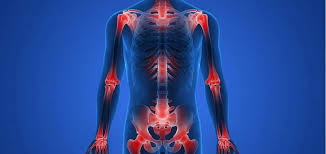Joint pain is a common complaint that affects millions of people worldwide. It can range from mild discomfort to severe, debilitating pain, making it essential to understand its types and causes. By identifying the underlying reasons for joint pain, individuals can seek appropriate treatments and prevent further complications.
Types of Joint Pain
1. Inflammatory Joint Pain
Inflammatory joint pain is caused by inflammation in the joints and surrounding tissues. It is often associated with autoimmune diseases and chronic conditions.
Common Causes:
- Rheumatoid Arthritis (RA): An autoimmune disorder that causes inflammation and pain in multiple joints.
- Psoriatic Arthritis: A condition linked to psoriasis that leads to joint pain and skin issues.
- Lupus: An autoimmune disease that can affect the joints, leading to swelling and pain.
- Gout: Caused by uric acid crystal buildup in the joints, leading to sudden and severe pain.
2. Degenerative Joint Pain
Degenerative joint pain occurs due to the gradual wear and tear of cartilage, leading to joint stiffness and discomfort.
Common Causes:
- Osteoarthritis: The most common form of arthritis, resulting from cartilage breakdown over time.
- Overuse Injuries: Repetitive stress on joints from physical activity or occupational tasks.
- Aging: Natural wear and tear on joints due to aging.
3. Infectious Joint Pain
Joint pain can result from infections that cause inflammation and swelling.
Common Causes:
- Septic Arthritis: Bacterial, viral, or fungal infections in a joint.
- Lyme Disease: A tick-borne infection that can lead to joint pain and swelling.
- Reactive Arthritis: Develops due to infections in other parts of the body, such as the urinary or gastrointestinal tract.
4. Traumatic Joint Pain
Injuries to the joints can cause acute or chronic pain, depending on the severity.
Common Causes:
- Sprains and Strains: Ligament and muscle injuries that cause joint instability.
- Fractures: Broken bones affecting the joint structure.
- Dislocations: The displacement of bones within a joint, leading to severe pain.
5. Metabolic Joint Pain
Certain metabolic disorders can contribute to joint pain by affecting bone and cartilage health.
Common Causes:
- Gout: Uric acid buildup leading to inflammation.
- Osteoporosis: Bone loss that increases the risk of fractures and joint pain.
- Hemochromatosis: Excess iron deposits that can damage joints.
Diagnosis and Treatment Options
Diagnosis
To determine the cause of joint pain, doctors may perform:
- Physical examination
- Blood tests to check for inflammation or infections
- Imaging tests (X-rays, MRI, CT scans)
- Joint fluid analysis
Treatment Approaches
Treatment varies based on the cause and severity of joint pain.
Medications
- NSAIDs (Nonsteroidal Anti-Inflammatory Drugs): Reduce pain and inflammation.
- Corticosteroids: Provide relief for severe inflammation.
- Disease-Modifying Antirheumatic Drugs (DMARDs): Used for autoimmune-related joint pain.
- Pain Relievers: Acetaminophen or opioids (in severe cases).
Lifestyle Modifications
- Weight Management: Reducing excess weight lessens joint stress.
- Exercise: Low-impact activities like swimming and yoga help maintain joint flexibility.
- Dietary Changes: Anti-inflammatory diets rich in omega-3 fatty acids, fruits, and vegetables can help manage symptoms.
Physical Therapy and Alternative Treatments
- Physical Therapy: Helps improve joint function and strength.
- Acupuncture and Chiropractic Care: Provide pain relief for some individuals.
- Hot and Cold Therapy: Can reduce swelling and stiffness.
Conclusion
Joint pain can arise from various conditions, including inflammation, infections, trauma, or metabolic disorders. Understanding the type and cause of joint pain is crucial for effective treatment and prevention. Early diagnosis and appropriate interventions can significantly improve quality of life, reduce discomfort, and prevent complications. Maintaining a healthy lifestyle, managing risk factors, and seeking medical advice when necessary are essential for joint health.
Frequently Asked Questions (FAQs)
1. When should I see a doctor for joint pain?
You should consult a doctor if you experience persistent joint pain, swelling, redness, or stiffness that does not improve with home remedies.
2. Can joint pain be prevented?
While not all types of joint pain can be prevented, maintaining a healthy weight, exercising regularly, and avoiding repetitive joint strain can reduce the risk.
3. Are natural remedies effective for joint pain?
Some natural remedies, like turmeric, omega-3 supplements, and herbal treatments, may help reduce inflammation and pain, but they should be used alongside medical treatments for best results.


Leave a Reply